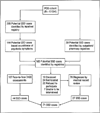Maternal iron deficiency and the risk of schizophrenia in offspring
- PMID: 18838630
- PMCID: PMC3656467
- DOI: 10.1001/archpsyc.65.10.1136
Maternal iron deficiency and the risk of schizophrenia in offspring
Abstract
Context: Iron is essential for brain development and functioning. Emerging evidence suggests that iron deficiency in early life leads to long-lasting neural and behavioral deficits in infants and children. Adopting a life course perspective, we examined the effects of early iron deficiency on the risk of schizophrenia in adulthood.
Objective: To determine whether maternal iron deficiency, assessed by maternal hemoglobin concentration during pregnancy, increases the susceptibility to schizophrenia spectrum disorders (SSDs) among offspring.
Design: Data were drawn from a population-based cohort born from 1959 through 1967 and followed up for development of SSD from 1981 through 1997.
Participants: Of 6872 offspring for whom maternal hemoglobin concentration was available, 57 had SSDs (0.8%) and 6815 did not (99.2%).
Main outcome measure: Prospectively assayed, the mean value of maternal hemoglobin concentration was the primary exposure. Hemoglobin concentration was analyzed as a continuous and a categorical variable.
Results: A mean maternal hemoglobin concentration of 10.0 g/dL or less was associated with a nearly 4-fold statistically significant increased rate of SSDs (adjusted rate ratio, 3.73; 95% confidence interval, 1.41-9.81; P = .008) compared with a mean maternal hemoglobin concentration of 12.0 g/dL or higher, adjusting for maternal education and ethnicity. For every 1-g/dL increase in mean maternal hemoglobin concentration, a 27% decrease in the rate of SSDs was observed (95% confidence interval, 0.55-0.96; P = .02).
Conclusions: The findings suggest that maternal iron deficiency may be a risk factor for SSDs among offspring. Given that this hypothesis offers the potential for reducing the risk for SSDs, further investigation in independent samples is warranted.
Figures
References
-
- Scholl TO, Reilly T. Anemia, iron and pregnancy outcome. J Nutr. 2000;130(2S suppl):443S–447S. - PubMed
-
- Cannon M, Jones PB, Murray RM. Obstetric complications and schizophrenia: historical and meta-analytic review. Am J Psychiatry. 2002;159(7):1080–1092. - PubMed
-
- Dalman C, Thomas HV, David AS, Gentz J, Lewis G, Allebeck P. Signs of asphyxia at birth and risk of schizophrenia, population-based case-control study. Br J Psychiatry. 2001;179:403–408. - PubMed
-
- Zornberg GL, Buka SL, Tsuang MT. Hypoxic-ischemia-related fetal/neonatal complications and risk of schizophrenia and other non-affective psychoses:a 19-year longitudinal study. Am J Psychiatry. 2000;157(2):196–202. - PubMed
Publication types
MeSH terms
Grants and funding
LinkOut - more resources
Full Text Sources
Other Literature Sources
Medical


